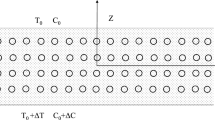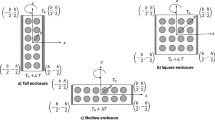Abstract
Stability and heat transfer efficiency of the Rayleigh–Bénard-convective system (RBCS) in a vertically vibrated very-shallow cylinder are investigated in the paper for two conventional nanoliquid media, i.e., water-aluminum and water-AA7075 nanoliquids. Using a normal mode solution involving zeroth- and first-order Bessel functions, linear stability analysis is performed. The influence of added aluminum and AA7075 nanoparticles, and sinusoidal waveform of vertical vibration on the onset in a RBCS is reported by obtaining analytical expressions for the marginal and the correction Rayleigh numbers. A minimum number of eigenfunctions is used to arrive at the modified, non-autonomous Lorenz model which is then projected into a Stuart–Landau equation using the method of multiscales. The solution of the Stuart–Landau equation is used to compute the time-averaged Nusselt number. The study reveals that the presence of nanoparticles in water is to destabilize the system and opposite is the influence of vertical vibration. For large frequency of periodic vibrations, its influence on the onset of convection is negligible. Further, the influence of nanoparticles in a baseliquid is to enhance heat transport and this can be used as a remedy for recovering the loss of heat due to a vertical vibration.








Similar content being viewed by others
References
Chandrasekhar S (1961) Hydrodynamic and Hydromagnetic Stability. Oxford University Press, Oxford
Platten JK, Legros JC (1984) Convection in Liquids. Springer, Berlin
Gershuni GZ, Zhukhovitskii EM (1963) On parametric excitation of convective instability. J Appl Math Mech 25:1197–1204
Gershuni GZ, Zhukhovitskii EM, Iurkov IS (1970) On convective stability in the presence of periodically varying parameter. J Appl Math Mech 34:442–452
Gresho PM, Sani RL (1970) The effects of gravity modulation on the stability of a heated fluid layer. J Fluid Mech 40:783–806
Ahlers G, Hohenberg PC, Lüke M (1985) Thermal convection under external modulation of the driving force. I. The Lorenz model. Phys Rev A 32:3493–3518
Ahlers G, Hohenberg PC, Lüke M (1985) Thermal convection under external modulation of the driving force. II. Experiments. Phys Rev A 32:3519–3534
Biringen S, Peltier LJ (1990) Computational study of 3-D Bénard convection with gravitational modulation. Phys Fluids A 2:279–283
Wheeler AA, Fadden GB, Murray BT, Coriell SR (1991) Convective stability in the Rayleigh-Bénard and directional solidification problems: high-frequency gravity modulation, Physics of Fluids A. Fluid Dyn 3:2847–2858
Rogers JF, Schatz MF (2000) Rayleigh–Bénard convection in a vertically oscillated fluid layer. Phys Rev Lett 84:87–90
Venezian G (1969) Effect of modulation on the onset of thermal convection. J Fluid Mech 35:243–254
Shu Y, Li BQ, Groh DHC (2002) Magnetic damping of g-jitter induced double-diffusive convection. Numer Heat Transp 42:345–364
Boulal T, Aniss S, Belhaq M, Rand R (2007) quasiperiodic gravitational modulation on the stability heated fluid layer. Phys Rev E 76:056320
Siddheshwar PG, Abraham A (2007) Rayleigh–Bénard convection in a dielectric liquid: time-periodic body force. Proc Appl Math Mech 7:2100083–2100084
Siddheshwar PG (2010) A series solution for the Ginzburg–Landau equation with a time-periodic coefficient. Appl Math 1:542–554
Bhadauria BS, Siddheshwar PG, Kumar J, Suthar OP (2012) Weakly nonlinear stability analysis of temperature/gravity-modulated stationary Rayleigh–Bénard convection in a rotating porous medium. Transp Porous Media 92:633–647
Siddheshwar PG, Bhadauria BS, Mishra P, Srivastava AK (2012) Study of heat transport by stationary magneto-convection in a Newtonian liquid under temperature or gravity modulation using Ginzburg–Landau model. Int J Non-Linear Mech 47:418–425
Siddheshwar PG, Revathi BR (2013) Effect of gravity modulation on weakly non-linear stability of stationary convection in a dielectric liquid, World Academy of Science. Eng Technol 7:119–124
Wadih M, Roux B (1988) Natural convection in a long vertical cylinder under gravity modulation. J Fluid Mech 193:391–415
Masuda H, Ebata A, Teramae K, Hishinuma N (1993) Alteration of thermal conductivity and viscosity of liquid by dispersing ultra-fine particles: dispersion of \(Al_2O_3\), \(SiO_2\) and \(TiO_2\) ultra-fine particles. Netsu Bussei 7:227–233
Choi SUS (1995) Enhancing thermal conductivity of fluids with nanoparticles. In: ASME international mechanical engineering congress and exposition W-31109-ENG-38. pp 99–105
Eastman JA, Choi SUS, Li S, Yu W, Thompson LJ (2001) Anomalously increased effective thermal conductivities of ethylene glycol-based nanofluids containing copper nanoparticles. Appl Phys Lett 78:718–720
Khanafer K, Vafai K, Lightstone M (2003) Buoyancy-driven heat transfer enhancement in a two-dimensional enclosure utilizing nanoliquids. Int J Heat Mass Transf 46:3639–3653
Kanchana C, Zhao Y, Siddheshwar PG (2018) A comparative study of individual influences of suspended multiwalled carbon nanotubes and alumina nanoparticles on Rayleigh–Bénard convection in water. Phys Fluids 30:084101
Siddheshwar PG, Meenakshi N (2016) Amplitude equation and heat transport for Rayleigh–Bénard convection in Newtonian liquids with nanoparticles. Int J Appl Comput Math 3:271–292
Siddheshwar PG, Veena BN (2018) A theoretical study of natural convection of water-based nanoliquids in low-porosity enclosures using single-phase model. J Nanof 7:163–174
Buongiorno J (2006) Convective transport in nanofluids. ASME J Heat Transf 128:240–250
Siddheshwar PG, Kanchana C (2019) Effect of trigonometric sine, square and triangular wavetype time-periodic gravity-aligned oscillations on Rayleigh–Bénard convection in Newtonian liquids and Newtonian nanoliquids. Meccanica 54:451–469
Kanchana C, Siddheshwar PG, Zhao Y (2020) Regulation of heat transfer in Rayleigh–Bénard convection in Newtonian liquids and Newtonian nanoliquids using gravity, boundary temperature and rotational modulations. J Therm Anal Calorim 142:1579–1600
Siddheshwar PG, Meenakshi N (2019) Comparison of the effects of three types of time-periodic body force on linear and non-linear stability of convection in nanoliquids. Eur J Mech B Fluids 77:221–229
Kanchana C, Su Y, Zhao Y (2020) Study of the effects of three types of time-periodic vertical oscillations on the linear and nonlinear realms of Rayleigh–Bénard convection in hybrid nanoliquids. Chin J Phys 68:542–557
Sharma J, Gupta U, Wanchoo RK (2016) Magneto binary nanofluid convection in porous medium. Int J Chem Eng 2016
Siddheshwar PG, Lakshmi KM (2019) Darcy–Bénard convection of Newtonian liquids and Newtonian nanoliquids in cylindrical enclosures and cylindrical annuli. Phys Fluids 31:084102
Ahuja J, Sharma J (2020) Rayleigh–Bénard instability in nanofluids: a comprehensive review. Micro Nano Syst Lett 8
Gupta U, Sharma J, Davi M (2021) Double-diffusive instability of Casson nanofluids with numerical investigations for blood-based fluid. Eur Phys J Plus 230:1435–1445
Devi M, Sharma J, Gupta U (2022) Effect of internal heat source on Darcy-Brinkman convection in a non-Newtonian Casson nanofluid layer. J Porous Med 25
Jules K, Hrovat K, Kelly E, McPherson K, Reckart T (2002) International space station increment-2 microgravity environment summary report, Technical report 211335, NASA
Chen J, Dong J, Yao Y (2021) Experimental study on the starting-up and heat transfer characteristics of a pulsating heat pipe under local low-frequency vibrations. Energies 14:6310
Buschmann MH (2013) Nanofluids in thermosyphons and heat pipes: overview of recent experiments and modelling approaches. Int J Therm Sci 72:1–17
Dey D, Sahu DS (2020) A review on the application of the nanofluids. Heat Transf 1–43
Cekmecelioglu D (2021) Convective heat transfer in food process engineering. In: Engineering principles of unit operations in food processing, pp. 315–344
Wang B, Ma D, Chen C, Sun D (2012) Linear stability analysis of cylindrical Rayleigh–Bénard convection. J Fluid Mech 711:27–39
Davis JR (2001) Aluminum and aluminum alloys. Understanding the Basics. ASM International, Alloying
Hamilton RL, Crosser OK (1962) Thermal conductivity of heterogeneous two component systems. Ind Eng Chem Fundam 1:187–191
Brinkman HC (1952) The viscosity of concentrated suspensions and solutions. J Chem Phys 20:571–571
Yu J, Goldfaden A, Flagstad M, Scheel JD (2017) Onset of Rayleigh–Bénard convection for intermediate aspect ratio cylindrical containers. Phys Fluids 29:024107
Swaminathan A, Garrett SL, Poese ME, Smith RWM (2018) Dynamic stabilization of the Rayleigh–Bénard instability by acceleration modulation. J Acoust Soc Am 144:2334–2343
Acknowledgements
P.G.S. and K.C. are grateful to the Universidad de Tarapacá, Chile, for supporting their research work. D.L. acknowledges partial financial support from Centers of Excellence with BASAL/ANID, Chile Financing, AFB180001, CEDENNA. The authors thank the Reviewers for most useful comments.
Author information
Authors and Affiliations
Corresponding author
Ethics declarations
Conflict of interest
The authors declare that they have no conflict of interest.
Additional information
Publisher's Note
Springer Nature remains neutral with regard to jurisdictional claims in published maps and institutional affiliations.
Appendix: Derivation of Eqs. (9) from (2)
Appendix: Derivation of Eqs. (9) from (2)
Applying curl twice on the momentum equation (2) and considering the z component, we get
The definition of curl operation on \(\mathbf {G}\) in cylindrical coordinate system is:
where \(\theta\) represents the azimuthal angle, \(({\hat{e}}_r, {\hat{e}}_{\theta }, {\hat{e}}_z)\) are unit vectors corresponding to the coordinates \((r, \theta , z)\) respectively and \((G_r, G_{\theta }, G_z)\) are the \((r, \theta , z)\) components \(\mathbf {G}\).
Using the above definition of curl into \(\mathbf {q}\) (which is two-dimensional) gives us,
Applying curl once again to Eq. (A3) and considering only the \(z -\) component, we get
Using the continuity equation (8) in the above equation gives us
where \(\nabla ^2 = \dfrac{\partial ^2 }{\partial r^2}+\dfrac{1}{r}\dfrac{\partial }{\partial r}+\dfrac{\partial ^2}{\partial z^2}\).
Further,
Furthermore, applying curl to the gradient of pressure gives us,
The last term of Eq. (A1) is written as:
Using curl once to \(T {\hat{e}}_z\), we get
Applying curl once again to the above equation and considering only z component, we get
Substituting Eqs. (A4)–(A7) and Eq. (A10) in Eq. (A1) and rearranging, we get the momentum equation of the form of Eq. (9).
Rights and permissions
Springer Nature or its licensor (e.g. a society or other partner) holds exclusive rights to this article under a publishing agreement with the author(s) or other rightsholder(s); author self-archiving of the accepted manuscript version of this article is solely governed by the terms of such publishing agreement and applicable law.
About this article
Cite this article
Siddheshwar, P.G., Kanchana, C., Laroze, D. et al. Rayleigh–Bénard convection of water-aluminum and water-AA7075 nanoliquids in a vertically vibrated very-shallow cylinder. Meccanica 57, 2963–2979 (2022). https://doi.org/10.1007/s11012-022-01608-3
Received:
Accepted:
Published:
Issue Date:
DOI: https://doi.org/10.1007/s11012-022-01608-3




